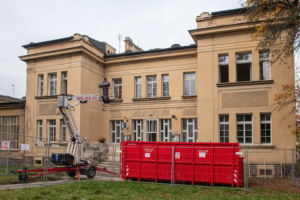Pilot Details |
|
|---|---|
| Pilot Name | The refinancing concept for subsidized EPC projects applied in the Bohnice Psychiatric Hospital in Czechia |
| Client Type | Public organisation |
| Country | Czech Republic |
| Solution Type |
|
Provider of the EPC project in Psychiatric Hospital Bohnice is a consortium of Veolia Energie CR, Ltd. and D-energy Ltd.
Veolia Energie ČR, a.s. is one of the largest producers and suppliers of heat in the Czech Republic, where it has been operating since 1991 in particular in the Moravian-Silesian, Olomouc, Central Bohemia, Karlovy Vary and Prague regions. It provides its clients with comprehensive energy services and is a major independent producer of electricity.
In 2021 Veolia Energie ČR, a.s. supplied district heat to half a million households, 512 industry clients and 323 healthcare facilities. It had 2,500 employees; its turnover was 19.5 million CZK and it sold 3,736 GWh of electricity and 24,561 TJ of heat.
D-energy s.r.o. was founded in 2010 with the aim of providing comprehensive services in the field of energy savings. The portfolio of activities offered has gradually grown and currently offers a truly wide range of services including consulting activities, design work, general supply of technologies and buildings, energy management, etc. The current main focus is the provision of energy services, especially in the context of EPC projects. Since 2012 it is a member of the Association of Energy Service Providers (APES).
Breakdown
Refinancing Instruments
A new model of refinancing of EPC projects subsidized by the State Environmental Fund (SEF) was tested in the Bohnice Psychiatric Hospital. The SEF rules for subsidized EPC projects had to be modified to allow for the sale of receivables from subsidized projects. Special guidelines for SEF-subsidised EPC projects have been developed and can be downloaded here. A model tripartite agreement to be signed between the bank, the ESCO and the EPC client can be downloaded here.
A new model of refinancing of EPC projects subsidized by the State Environmental Fund (SEF) was tested in the Bohnice Psychiatric Hospital. The SEF rules for subsidized EPC projects had to be modified to allow for the sale of receivables from subsidized projects. Special guidelines for SEF-subsidised EPC projects have been developed and can be downloaded here. A model tripartite agreement to be signed between the bank, the ESCO and the EPC client can be downloaded here.
Financing of the comprehensive renovation in the Psychiatric Hospital has the following structure:
- Financing of the EES project includes subsidy, thus the set of EEI measures must fulfil the requirement of 30% energy savings to be eligible for the subsidy program. There are two financial flows – firstly, the State Environmental Fund (SEF) provides subsidy to the EPC client and secondly, later, the EPC client pays the same financial amount to the EPC provider.
- Supplier credit, which will be later refinanced was limited by maximum threshold.
- Own resources of the client were also used.
In the Czech Republic, the EPC provider (ESCO) typically sells receivables to the bank after the implementation of the energy saving measures, and thus obtain funding for other projects. Until recently, sale of receivables was not allowed for EPC projects that used subsidies from the Operational Programme Environment (OPE) operated by the State Environmental Fund (SEF). The reason was that the subsidy programme, which always financed only part of the contract, strictly required that the remaining part of the project costs be reimbursed within 10 days after the subsidy was provided. At the same time, each payment had to be supported by a bank statement proving that the client had paid the amount from its bank account directly to the account of the provider. However, this was not possible in the case of the sale of receivables, because in such a case the provider would receive the payment for receivables from the bank, not from the client.
Therefore, the effort was made to find a way to meet the requirements of the subsidy programme and at the same time allow refinancing so that the EPC provider can eliminate the long-term debt burden. After complex negotiations, a tripartite agreement was proposed, which replaced the required proof of reimbursement of the cost by the client. The agreement obliges the bank, the provider and the client to take a common procedure in the form of preparing the sale of receivables before receiving the subsidy and transferring funds to the provider no later than 10 days after receiving the subsidy.
During the process of pilot project implementation, adjustments to the concept had been negotiated with SEF to enable implementation of the EPCs subsidized from OPE and to increase the economic viability of the projects. SEF enabled to adjust the set of EEI measures and reallocate the subsidy amount after procurement procedure. This is a necessary precondition as during EPC procurement via competitive procedure with negotiation the set of EEI measures and thus costs of measures change during the process. Key economic parameters in tender documentation have to be adjusted accordingly during procurement process.
Contractual stipulations
The goal was to amend guidelines of the OPE subsidy program operated by the State Environmental Fund (SEF), so the standard EPC projects may be combined with OPE subsidies. Importantly, this means EPC provider will be able to meet the requirements while selling receivables to a bank after the implementation of the energy saving measures. Also, the aim was also to allow for certain changes in the set of EPC measures after submission of the subsidy application as such changes usually occur during the competitive procedure with negotiation used to select an EPC provider.
When applying for the subsidy payment, the Rules for applicants and beneficiaries of support in the Operational Programme Environment for the period 2021-2027 require the beneficiary to provide the following:
- proof of the payment;
- an approved and signed “EPC Application”;
- the relevant invoices and their possible partial payment;
- a Tripartite Agreement between the provider, the bank and the beneficiary, where the exact amount of the assigned receivables will be specified; Tripartite Agreement may also be replaced by two contracts (provider x bank + provider x beneficiary), with the same legal impact as in the case of the Tripatite Agreement;
- a bank statement proving the payment of the assigned receivable by the bank to the provider.
The new stipulations in the Guidelines allow that the Tripartite Agreement between the client, ESCO and financial institution replaces the proof of reimbursement of the cost by the client required by SEF.
The new table added to the Guidelines provide calculation of changes in budgets between submission of subsidy application and the final set of EEI measures of the EPC project. Changes have to be reflected in an amendment to the EPC contract.
SEVEn has also created a methodology approved by SEF on how the allocated subsidy funds can be rolled over from one measure to another.



Photos: Tomas Bican
The pilot application in the Psychiatric Hospital Bohnice has shown that the refinancing concept is applicable for the comprehensive renovations of buildings in the Czech Republic, which combine EPC with subsidies from OPE. Adjustments are being included in the OPE rules, making it more accessible for EPC projects. The following conclusions can be extracted from these experiences:
- Months of negotiations were needed to amend the SEF public scheme rules so the receivables from EPC projects subsidised may be sold to banks. In particular, the following barriers were removed:
- A tripartite agreement among the ESCO, the private bank and the client replaced the proof of cost reimbursement claimed by the ESCO to the client that SEF usually requests.
- A change on the selected EEI measures with respect to the original plan foreseen at the subsidy application. Although SEF grants the subsidy based on the original proposal, certain degree of flexibility for reallocating the funds to different EEI measures was allowed.
- The early payment to the ESCOs was introduced as an optional feature catered to bridge the up-front financial gap and to mitigate the impact of inflation.
- The success of this adjusted refinancing scheme brought positive results for the EES market, namely:
- Growing interest among providers -– currently there are more than 20 most of 20 EPCs in preparation and most of them are combined with subsidies.
- Growing interest among potential clients as it is possible to obtain subsidies for EPCs.
- The average size of the EPCs multiplied by four from 1 to 2 mil. € to 4-8 mil. €.
- Combining EPC with subsidies enables combining technology measures and construction measures in deep renovation projects – otherwise would be possible only with a large proportion of the client’s own resources.
- Sale of receivables allow SMEs as EPC providers to implement combinations with subsidies (not just large companies).
Czech case provides an example of procurement procedure which ensures that inclusion of subsidies do not prevent the client to select the economically optimal solution.
For more information, please contact:


